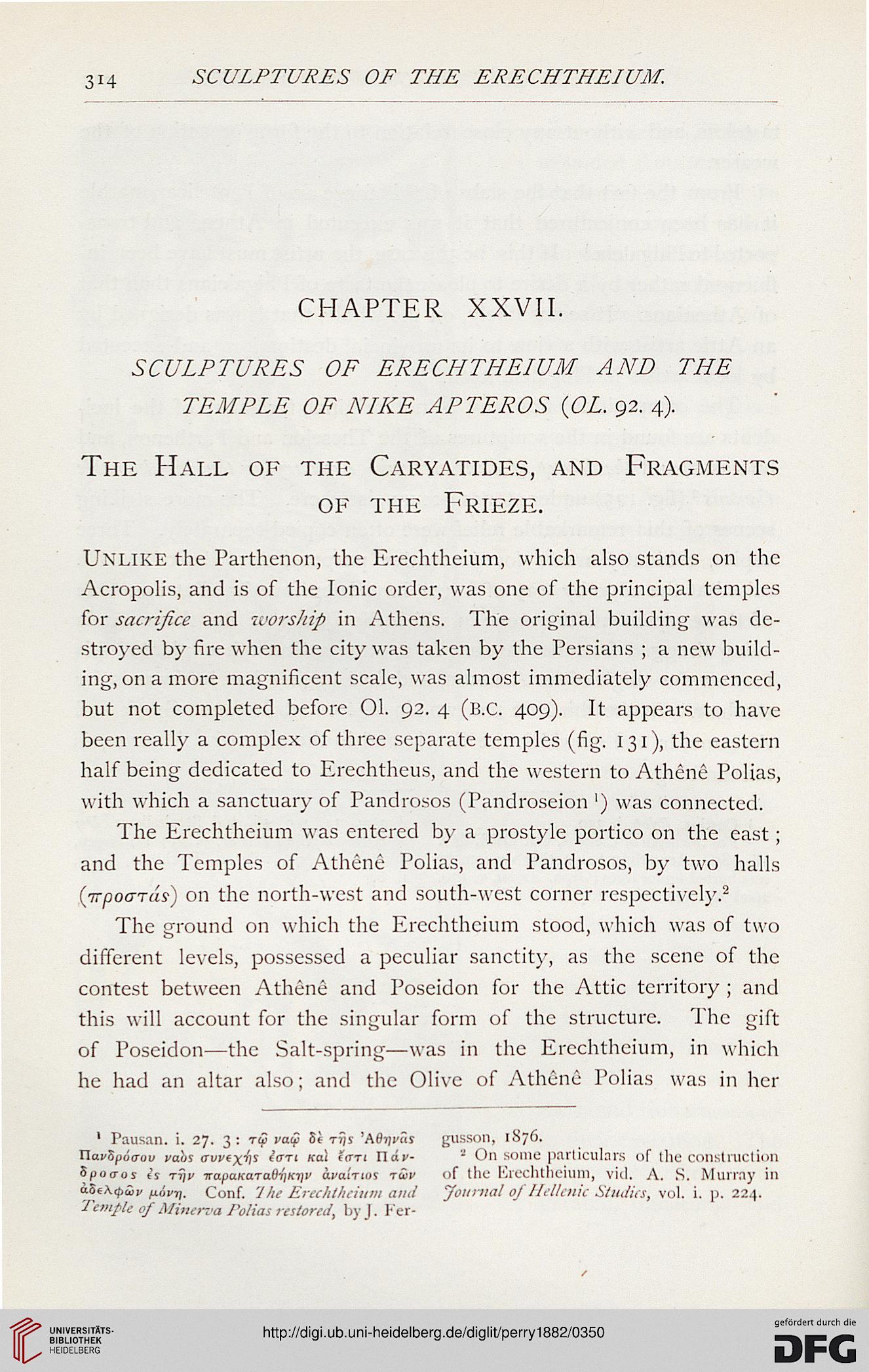3r4
SCULPTURES OF THE ERECHTHEIUM.
CHAPTER XXVII.
SCULPTURES OF ERECHTHEIUM AND THE
TEMPLE OF NIKE APTEROS {OL. 92. 4).
The Hall of the Caryatides, and Fragments
of the Frieze.
UNLIKE the Parthenon, the Ercchthcium, which also stands on the
Acropolis, and is of the Ionic order, was one of the principal temples
for sacrifice and worship in Athens. The original building was de-
stroyed by fire when the city was taken by the Persians ; a new build-
ing, on a more magnificent scale, was almost immediately commenced,
but not completed before 01. 92. 4 (B.C. 409). It appears to have
been really a complex of three separate temples (fig. 131), the eastern
half being dedicated to Erechtheus, and the western to Athene Polias,
with which a sanctuary of Pandrosos (Pandroseion ') was connected.
The Ercchthcium was entered by a prostyle portico on the east;
and the Temples of Athene Polias, and Pandrosos, by two halls
{irpoaTus) on the north-west and south-west corner respectively.2
The ground on which the Ercchthcium stood, which was of two
different levels, possessed a peculiar sanctity, as the scene of the
contest between Athene and Poseidon for the Attic territory ; and
this will account for the singular form of the structure. The gift
of Poseidon—the Salt-spring—was in the Ercchthcium, in which
he had an altar also; and the Olive of Athene Polias was in her
1 Pausan. i. 27. 3 : rip vaf Si Tfjs 'AflTjWis
riai>Zpu(Tuu vabs avv^x^s laTt Kai ttrrt T\dv-
Spoaos is tt)v irapaKaTa6i]Kf)v avatrius twc
aSf\<puy n&vr\. Conf. 7 he Ercchthcium ami
TempU of Btmefoa Polias restored, by J. Ker-
gusson, 1S76.
2 On some particulars of the construction
of the Erechtneium, vul. A. S. Murray in
Journal oj Hellenic Studies, vol. i. p. 224.
SCULPTURES OF THE ERECHTHEIUM.
CHAPTER XXVII.
SCULPTURES OF ERECHTHEIUM AND THE
TEMPLE OF NIKE APTEROS {OL. 92. 4).
The Hall of the Caryatides, and Fragments
of the Frieze.
UNLIKE the Parthenon, the Ercchthcium, which also stands on the
Acropolis, and is of the Ionic order, was one of the principal temples
for sacrifice and worship in Athens. The original building was de-
stroyed by fire when the city was taken by the Persians ; a new build-
ing, on a more magnificent scale, was almost immediately commenced,
but not completed before 01. 92. 4 (B.C. 409). It appears to have
been really a complex of three separate temples (fig. 131), the eastern
half being dedicated to Erechtheus, and the western to Athene Polias,
with which a sanctuary of Pandrosos (Pandroseion ') was connected.
The Ercchthcium was entered by a prostyle portico on the east;
and the Temples of Athene Polias, and Pandrosos, by two halls
{irpoaTus) on the north-west and south-west corner respectively.2
The ground on which the Ercchthcium stood, which was of two
different levels, possessed a peculiar sanctity, as the scene of the
contest between Athene and Poseidon for the Attic territory ; and
this will account for the singular form of the structure. The gift
of Poseidon—the Salt-spring—was in the Ercchthcium, in which
he had an altar also; and the Olive of Athene Polias was in her
1 Pausan. i. 27. 3 : rip vaf Si Tfjs 'AflTjWis
riai>Zpu(Tuu vabs avv^x^s laTt Kai ttrrt T\dv-
Spoaos is tt)v irapaKaTa6i]Kf)v avatrius twc
aSf\<puy n&vr\. Conf. 7 he Ercchthcium ami
TempU of Btmefoa Polias restored, by J. Ker-
gusson, 1S76.
2 On some particulars of the construction
of the Erechtneium, vul. A. S. Murray in
Journal oj Hellenic Studies, vol. i. p. 224.




